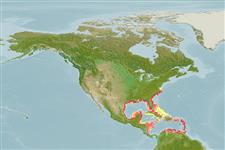Common names from other countries
>
Eupercaria/misc (Various families in series Eupercaria) >
Sciaenidae (Drums or croakers)
Etymology: Cynoscion: Greek, kyon = dog + Greek, odous = teeth + Greek, skion, skiaina = barbel, red mullet (Ref. 45335).
Environment: milieu / climate zone / depth range / distribution range
Ecologia
marinhas; estuarina demersal; intervalo de profundidade 2 - 18 m (Ref. 1183). Subtropical; 39°N - 9°N, 98°W - 59°W
Western Atlantic: Maryland to northeastern Florida in the USA and throughout Gulf of Mexico. Reported from Campeche Bank in Mexico (Ref. 5733). Often misidentified as Cynoscion regalis (Ref. 3702).
Comprimento de primeira maturação / Tamanho / Peso / Idade
Maturity: Lm 15.8, range 14 - 17 cm
Max length : 36.0 cm TL macho/indeterminado; (Ref. 3702); common length : 25.0 cm TL macho/indeterminado; (Ref. 3702); idade máx. registrada: 1.20 anos (Ref. 31629)
Espinhos dorsais (total) : 11; Raios dorsais (total) : 26 - 31; Espinhos anais: 2; Raios anais : 8 - 11; Vértebras: 27. Colour greyish above and changing abruptly to silvery below. Back and upper sides sometimes with very faint irregular rows of spots. Dorsal fin dusky, other fins pale to yellowish. Mouth large, oblique, lower jaw projecting. Upper jaw with a pair of large canine-like teeth at tip. Lower jaw with a row of sharp enlarged inner-row teeth, widely spaced. Chin without barbels or pores. Snout with 2 marginal pores. Gas bladder with a pair of straight, horn-like anterior appendages. Soft portion of dorsal fin covered with small scales on basal half of in (Ref 51721).
Occurs usually over sandy bottoms in inshore waters along beaches and in river mouths. Feeds mainly on crustaceans and fishes.
Ciclo de vida ou comportamento de acasalamento
Maturities | Reprodução | Spawnings | Egg(s) | Fecundities | Larvas
Robins, C.R. and G.C. Ray, 1986. A field guide to Atlantic coast fishes of North America. Houghton Mifflin Company, Boston, U.S.A. 354 p. (Ref. 7251)
Status na Lista Vermelha da UICN (Ref. 130435)
CITES (Ref. 128078)
Not Evaluated
Ameaça para os humanos
Harmless
Uso pelos humanos
Pescarias: pouco comercial
Ferramentas
Relatórios especiais
Baixar XML
Fontes da internet
Estimates based on models
Preferred temperature (Ref.
115969): 23.4 - 28, mean 26.8 (based on 492 cells).
Índice de diversidade filogenética (Ref.
82804): PD
50 = 0.5000 [Uniqueness, from 0.5 = low to 2.0 = high].
Bayesian length-weight: a=0.01230 (0.00776 - 0.01949), b=3.01 (2.88 - 3.14), in cm Total Length, based on LWR estimates for this species & Genus-body shape (Ref.
93245).
Nível Trófico (Ref.
69278): 4.0 ±0.60 se; based on food items.
Resiliência (Ref.
120179): médio(a), tempo mínimo de duplicação da população 1,4 - 4,4 anos (K=0.22).
Fishing Vulnerability (Ref.
59153): Moderate vulnerability (38 of 100).
